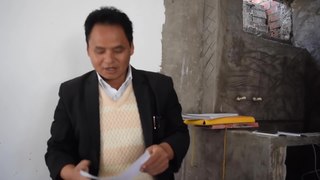Related Research Articles

Kawaimina is a syllabic abbreviation used to refer to four languages or dialects of East Timor:
Wetarese is an Austronesian language of Wetar, an island in the south Maluku, Indonesia, and of the nearby islands Liran and Atauro, the latter island located in East Timor north of Dili.
The Tutsa are a Naga tribe living in the southern parts of Changlang and the eastern part of Tirap districts of the Indian state of Arunachal Pradesh. Ethnically, the Tutsa are closely related to the Tangsa and were classified as members of the Tangsa in all census records until 1981. As of 2001 their population stood at 25,000.
Sha is an Afro-Asiatic language spoken in Plateau State and Kaduna State, Nigeria. As of 2018, the language is in use for face-to-face communication and has no standardized written form. The language is spoken by roughly 1000 people and is sustainable.
Bhujel, also called Bujhyal, is a Chepangic language spoken in central Nepal. It is a semi-tonal language, employing a complex array of affixes.
Chepang is a language spoken by approximately 37,000 people in Nepal. The people are known as Chepang. Randy LaPolla (2003) proposes that Chepang may be part of a larger "Rung" group.
The Konyak languages, or alternatively the Konyakian or Northern Naga languages, is a branch of Sino-Tibetan languages spoken by various Naga peoples in southeastern Arunachal Pradesh and northeastern Nagaland states of northeastern India. They are not particularly closely related to other Naga languages spoken further to the south, but rather to other Sal languages such as Jingpho and the Bodo-Garo languages. There are many dialects, and villages even a few kilometers apart frequently have to rely on a separate common language.
Bwisi is a language spoken mainly in the Kibangou District of the Republic of Congo, next to the Gabon border, where it is also spoken by a minority. According to the Ethnologue, approximately 4,250 people speak the language today worldwide.
Zeme is a Sino-Tibetan language spoken in northeastern India. It is one of the dialects spoken by the Zeme Naga, the other being Mzieme.
Brao is a Mon–Khmer language of Cambodia and Laos.
Maram is a Sino-Tibetan language spoken in India. It is taught up to secondary school, and the younger generations are almost fully literate.
Biate is a Sino-Tibetan language spoken by the Biate people in several parts of Northeast India: in Meghalaya, Assam, Mizoram, Manipur and Tripura. Biate is pronounced as Bia-te (the e in te pronounced as "a".

Maring and Uipo (Khoibu) are closely related Sino-Tibetan languages spoken by the Maring Naga and Khoibu (Uipo) Naga of India. Linguistically they are closest to the Tangkhulic languages.
Rongpo or Rangpo is a West Himalayish language spoken in Uttarakhand, India.
Kaiy is a Lakes Plain language of Papua, Indonesia. It is spoken in Kaiy and Kokou villages in Rafaer District, Mamberamo Raya Regency.
Pochuri, or Pochuri Naga, is a Naga language spoken in Nagaland, India.
Chaudangsi is a Sino-Tibetan language spoken in the Indian state of Uttarakhand.
Rabha is a Sino-Tibetan language of India. The two dialects, Maituri and Rongdani, are divergent enough to cause problems in communication. According to U.V. Joseph, there are three dialects, viz. Róngdani or Róngdania, Mayturi or Mayturia and Songga or Kocha. Joseph writes that "the Kocha dialect, spoken along the northern bank of the Brahmaputra, is highly divergent and is not intelligible to a Róngdani or Mayturi speaker". Joseph also writes that "[t]he dialect variations between Róngdani and Mayturi, both of which are spoken on the southern bank of the Brahmaputra, in the Goalpara district of Assam and belong to the northern slopes of Meghalaya, are minimal". He concludes the paragraph on dialectal variation with: "The Róngdani-Mayturi dialectal differences become gradually more marked as one moves further west".
Lohorung, also spelled Lorung, Lohrung or Loharung, is a Kirati languages language of eastern Nepal. It has been described by George van Driem.
Chothe is a Kuki-Chin language of India. It may be intelligible with Aimol.
References
- ↑ Tutsa at Ethnologue (18th ed., 2015)